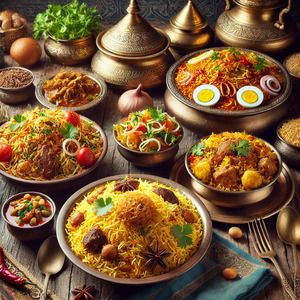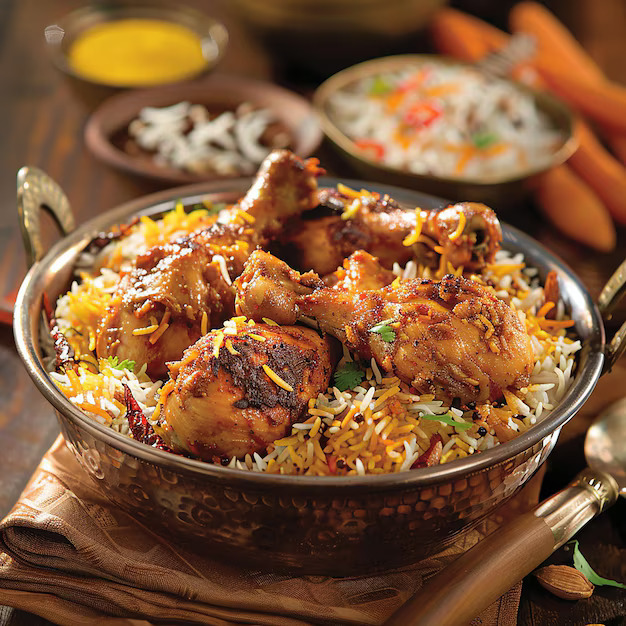Biryani: Mention of the word sends you into the world of aromatic spices, succulent meat, and soft rice melting in your mouth. It is not only a meal but an experience-very rich, multi-layered dish bringing history, culture, and comfort with every bite. Whether it’s some special occasion or just a simple Sunday meal, “Biryani” is undoubtedly the hero of Indian cuisine and a favorite among millions of hearts all over the world.
Now let’s dive a little deeper into the magic of biryani: that dish that has captured hearts and kitchens for centuries!
What Makes Biryani So Special?
So, what is so special and so great about this delightful concoction? It is way beyond just a meal-it’s a flavor revelry! Coming from Persian through the word “birian,” meaning “fried before cooking,” Mughal brought it to the lands of India where Indian chefs themselves refined it. This is really what gives specialty to biryani, when the long-grain basmati rice mixed with tender, marinated meat, preferably, is mixed with veggies and an addictive ensemble of spices like cardamom, cinnamon, cloves, and cumin. All of these come in perfecting layers in every morsel of it cooked altogether in one pot such that the flavor soaks inside every little grain of the rice.
But biryani is more about the process of preparation and sharing, rather than flavor. Indeed, it is a layered affair wherein the marinated meat lies between partially cooked rice and then slowly cooked, termed as “dum”, to infuse flavors within. And when that lid gets opened after hours of slow cooking? Fragrant steam and delectable aroma fill in the air, and people wait at the table for their share.
The Taste Symphony of Biryani: A Perfect Balance of Spices and Texture
Perhaps most dramatically of all, the subtle balance and delicate blending of flavors come together in a “delicious biryani” with perfectly combined elements; it’s the slightest bit so that tender meat or marinated vegetables just marry the perfectly cooked aromatic rice with a layer of spice and textures that are altogether far more complex than anyone could anticipate to find within “biryani”. Each bite is a symphony of warmth from cinnamon and cumin, freshness from mint and coriander, and sometimes sweetness from caramelized onions or bits of raisins.
The hero of the dish is the rice. It should be light, fluffy, and aromatic. All the flavors of spices and the meat must carry over to the rice, with every grain well-coated and flavored. Texture plays an equal role—it should not be sticky or overcooked but must have a slight bite so that the spices coat the surface and produce a flavor burst with every forkful.
However, it is the caramelized touch it imparts—at the last stage, when the biryani is made ‘dum’ style. Slow-cooking does well to combine everything inside and outside—the spices along with the meat disperse little packets of flavors throughout—and the crisp, crunchy golden-brown crust that forms above the rice is nothing short of perfection.It’s this perfect interplay of textures—soft and tender, crunchy and fluffy—along with aromatic flavors that makes “biryani” not just a meal but a complete experience of the senses.
The next time you dig into your plate of “delicious biryani,” listen to the interplay of textures and spices, and you’ll see why every bite is so uniquely satisfying!
Why does biryani win the hearts of everyone?
1. Aromatic and Flavorful:
Just the sheer fragrance of a perfectly made biryani can get your senses dancing. The use of ghee, saffron, and whole spices like cinnamon, cardamom, and cloves gives the dish an aromatic richness that is unmatched. These spices don’t just flavor the rice and the meat but create an experience that can linger long after the meal is over.
2. Versatility at Its Best:
It’s one of those dishes which could be prepared using chicken, mutton, beef, or even vegetables; therefore, ideal for everyone’s taste buds. If you are in the mood for something hot and spicy, or you fancy something tangy and sour, or even prefer mild taste, there is a style of biryani that suits your taste. Moreover, the dish gives much scope for alteration, for each region has a special touch to this particular dish-from the yogurt-marinated Hyderabadi biryani to the boiled-egg-laden Kolkata biryani.
3. For All Seasons:
Biryani is not just a dish; it is a part of a celebration. It is served on weddings, family reunions, or festivals like Eid or Diwali. Biryani is that dish which brings people together. It is the act of preparing and serving biryani that is a shared exercise among friends and family. Therefore, the art of making biryani stands as a mark of togetherness, celebration, and indulgence.
Though it seems that a dish like biryani demands experience and perfection, all it actually demands is the harmony of flavors and waiting time. This is how one can prepare the good-old-fashioned traditional biryani at home in a simple manner.
1. Marinating the Meat (or Vegetables)
To marinate, take the meat-chicken, mutton, or vegetables-and soak it in a mixture of yogurt, ginger-garlic paste, red chili powder, turmeric, garam masala, and some fresh herbs like coriander and mint. Let this sit for some hours-or overnight-so that the flavors have time to seep into the meat.
2. Cooking the Rice
The basmati rice is first washed to remove excess starch, then partially cooked with whole spices such as cardamom, cloves, and bay leaves. In this manner, it absorbs the spices and becomes flavored but firm in texture.
3. Layering the Biryani
Sprinkle small onion bits, fresh coriander, mint leaves, and saffron-infused milk over the layer of the cooked rice over marinated meat in a heavy bottomed pot. Seal it tightly-mostly by dough, cook on low flame for 45 to 60 minutes till the flavors are nicely integrated.
4. Service
Once cooked, tenderly fluff the biryani, serve hot with cooling raita (spiced up yogurt), side salad, and maybe a boiled egg or pickle with a zing.
Regional Biryani Variations of India
The beauty of biryani lies in its diversity. Every region in India — and indeed the whole world — has something unique to say about the iconic dish.

Hyderabadi Biryani: This is one of the spiciest and sourest. The meat is marinated but mainly cooked with rice through the “dum” method. Richness is there due to added yogurt and fried onions.
Lucknowi (Awadhi) Biryani: The Lucknowi biryani is not that spicy. In fact, it’s nothing like a spiced variation. Layering is followed by partly cooked rice and meat together, followed by a slow-cooking process. Arromatic and not too much, thus much less spicy than its similarly flavored version Hyderabadi biryani.
Kolkata Biryani: It is mixed style of Mughlai and Bengali style. Boiled potatoes and boiled eggs are used for preparation. Kolkata biryani is less spicy and lighter in taste.
Malabar Biryani: It is prepared from Kerala with short-grain rice and normally served with spicy, tangy curry.
Vegetable Biryani: The vegetarian variant of the recipe, containing mixed vegetables, nuts, and raisins. Taste almost as deliciously good as its non-vegetarian cousins, but much less heavy, and just as satisfying.
Tips to make Biryani more better
1. Fresh Produce:
The difference to the biryani flavor makes adding fresh herbs like mint and coriander. Freshness and superior quality of the meat or the vegetables used will give in the difference of taste as well as texture when talking about this particular dish.
2. Do not be Stinted on Ghee:
All the depth as well as richness goes in the dishes with ghee. There is no wonder if using oil instead of ghee tastes and smells quite un-authentic.
3. Slow Cook (Dum Cooking):
Patience makes biryani is a job. Slowing down the spices seeps into the rice and the meat. Don’t make it so fast!
4. Balanced Flavors:
There should be more flavour in this biryani, without being hot. Taste the marinade first and adjust spices according to your taste to ensure that there is a mix of those flavors that taste harmonious.
Beyond the Plate: The Biryani Experience
It cannot be termed as a meal, but it can certainly be viewed as a culture; something huge, something that can tell stories-be it about the history attached, rich culture along with the great love that each of those dishes would taste so amazingly awesome. And it does the job so nicely when served in weddings, and special occasion feasts, even the simple dinner in the homes because it makes such wonderful memories of union, enjoyment, and a role-model for food that transcends its border lines as something enjoyable.
Next time, when you would want something that is rich in aroma and fulfilling, enter a pot of biryani, much more than a meal, this is a regal experience, every single grain.



